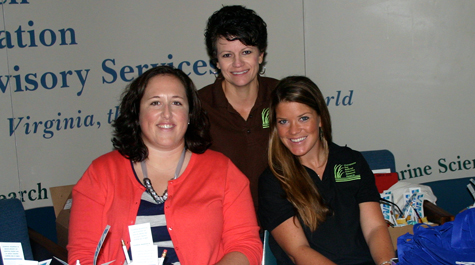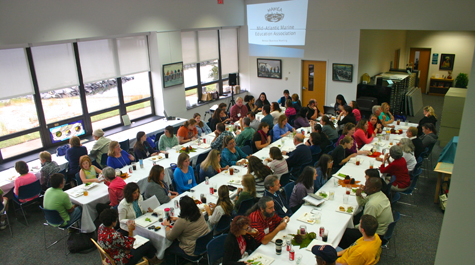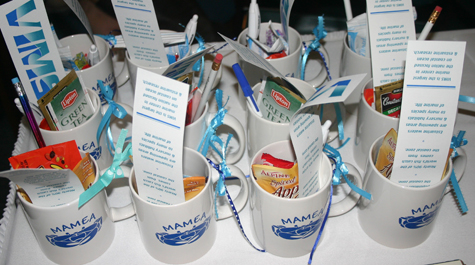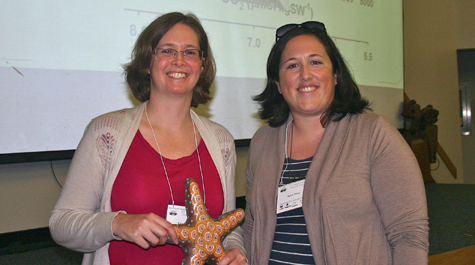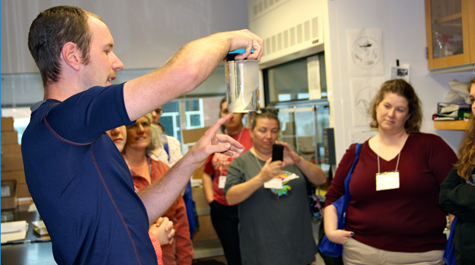Annual MAMEA conference held at VIMS
Marine science educators network, discuss latest trends in the field
Marine educators from Delaware to North Carolina traveled to the Virginia Institute of Marine Science last week for the Mid-Atlantic Marine Education Association’s annual conference.
Now in its 35th year, MAMEA aims to improve education pertaining to all aspects of marine and aquatic environments. A regional chapter of the National Marine Educators Association (NMEA), MAMEA gives marine educators from the mid-Atlantic region an opportunity to share experiences and look to the future of marine education.
Sarah Nuss, Education Coordinator for the Chesapeake Bay National Estuarine Research Reserve at VIMS, has served as MAMEA’s president-elect for the past year, and became the Association’s official president during the conference. “It’s such an honor to be president of MAMEA,” says Nuss. “During my term, I hope to visit as many of the regional mini-conferences as I can so that I can meet other MAMEA members, and hopefully welcome some new members to our group.”
Each year, the president-elect is responsible for hosting MAMEA’s annual conference. Nuss—along with a planning committee made up of other member of the VIMS staff—decided VIMS would be the perfect place for this year’s event. VIMS Marine Education specialists Lisa Ayers-Lawrence, Jaclyn Beck, and Carol Hopper Brill helped Nuss bring the conference to fruition.
“The conference gives educators from our region the ability to catch up on the latest opportunities and lesson ideas in marine science,” says Hopper Brill. “It’s a great source of professional development because we exchange ideas with each other, and that makes us more creative and effective.”
This year’s conference consisted of more than 80 participants from Virginia, Maryland, North Carolina, Washington, D.C., and beyond. The three-day event featured board meetings, a canoe-based field trip, auctions, a tour of VIMS, and even a Mexican fiesta.
“The annual conference is a chance for our membership to gather as a whole,” says Nuss. “During the conference we network, learn about new research and education projects taking place in marine science, and present new information to our colleagues.”
In addition to the various activities featured at the conference, two scientists were invited to share their expertise with MAMEA members. Dr. Richard Brill, an internationally recognized fish physiologist who heads NOAA’s Cooperative Marine Education and Research (CMER) program at VIMS, gave a talk titled, “Keeping Sharks Away From Fishing Gear: Can We Save Sharks From People-Attacks?” The following day, the conference’s plenary speaker was Dr. Victoria Hill from Old Dominion University, who spoke about her experience working in the Arctic Ocean in a talk titled, “Living and Working in the Freezer.”
“Our guest speakers described research that addresses current issues of concern in ways that clearly outline the scientific process, and gave participants new insights into the topics,” says Hopper Brill. “Educators love to have current examples of how science is applied to address problems, because those are the issues that get their students’ attention.”
Nuss says she and her colleagues are very happy with the turnout for this year’s conference. “Typically, we plan conferences with the thought that around 60 people will attend, so seeing more than 80 people attend makes this a great year for MAMEA,” she says.
In July, MAMEA is hosting the annual National Marine Educators Association conference in Annapolis, Maryland, an event that is held in one of NMEA’s 17 regions each year. “It’s a huge honor to be able to represent our organization, along with my fellow MAMEA members, and welcome all of NMEA to our region for what will be a superb national conference,” says Nuss.
The Mid-Atlantic Marine Education Association is made up of marine science educators from a variety of settings, including classrooms, research institutions, aquariums, museums, and governmental agencies from North Carolina to Delaware. Membership is available for anyone interested in marine and aquatic education. For additional information, visit the MAMEA website at www.mamea.org.


